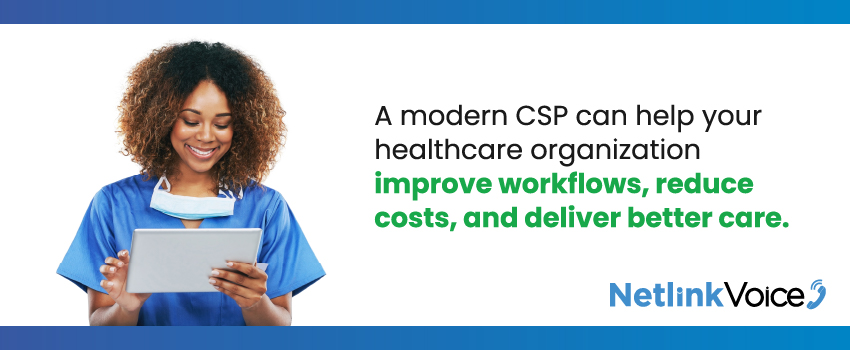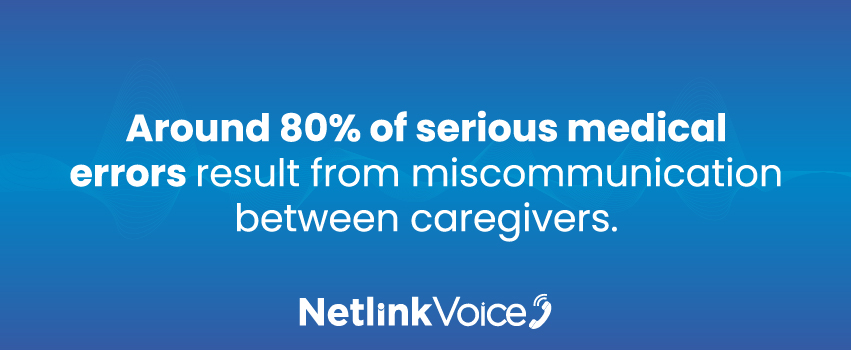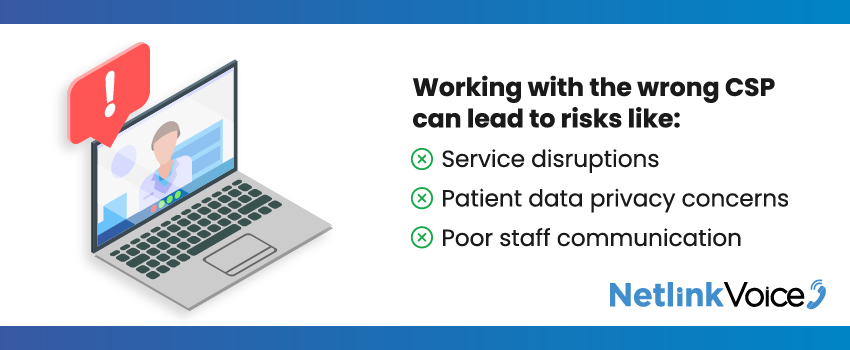Seamless connectivity and efficient communication are essential for healthcare organizations to provide quality patient care. Poor communication can impact everything from the patient experience – 42% of people say it takes too much effort to connect with their healthcare provider1 – to the ability of clinicians to treat patients, as evidenced by the estimated 80% of serious medical errors resulting from miscommunication between caregivers.2
A lot is riding on the communications infrastructure of every healthcare organization, which is why understanding the role of communication service providers (CSPs) is crucial. In this blog, we’ll explore what a CSP is, why they’re important for healthcare, and how choosing the right provider can empower your staff to deliver better patient care.
What Is a Communication Service Provider (CSP)?
A communications service provider, or CSP, offers communication services such as telephony, internet access, and data transmission. But as with all technology providers, the landscape of CSPs is ever-evolving. In addition to traditional telecommunications services, many CSPs now offer unified communications as a service (UCaaS), cloud solutions, and more to meet the diverse needs of today’s businesses.

The Evolution of Communications Service Providers
Before the 1990s, communications companies were highly specialized, with little overlap between traditional telephone companies, cellular carriers, cable providers, and internet service providers (ISPs). But in the 1990s, deregulation and technological advancements began driving convergence across these previously discrete sectors.
Specifically, the Telecommunications Act of 1996 in the United States opened the door for increased competition and new services in the industry. Additionally, the rapid development of fiber optic networks and IP-based technologies enabled companies to bundle multiple communication services over a single platform. As businesses began offering more integrated bundles of voice, data, video, and mobile services to customers, traditional categorizations like “telephone company” or “ISP” no longer sufficiently described these expanded providers.
The umbrella term “communications service provider” emerged to define this new breed of consolidated companies offering diverse connectivity services. The massive investments in high-speed networks and infrastructure during this period also positioned CSPs to enable the high-bandwidth applications and innovations that have come to define communication technology today. While specialization still exists in the industry, the CSP model of consolidated voice, data, cloud, mobility, and other services has become a central pillar of the modern telecommunications landscape.
Why are CSPs Important for Healthcare?
Reliable, efficient communication is essential for healthcare organizations to deliver better care and ensure patient satisfaction. Choosing the right communication service provider can give your company the tools needed to enable:
- Connectivity and Communication: At the core, CSPs enable connectivity. Whether it’s a phone call or a high-speed internet connection, these services are essential for both personal and business communications.
- Business Operations: For businesses, CSPs are the backbone of operations. They provide the tools and platforms for internal and external communication, collaboration, and customer engagement.
- Innovation and Growth: CSPs are at the forefront of technological innovation in communication. By offering advanced services like cloud communications and VoIP, they empower businesses to stay ahead in the competitive market.

What Are the Types of Communication Service Providers?
Healthcare organizations have several options when selecting a communications service provider. The main categories of CSPs are:
- Telecommunication service providers, which offer landline and wireless connections, cable, and satellite transmission.
- Entertainment service providers, which enable TV, movies, music, and other entertainment through niche television channels, music platforms, and other digital services.
- Media/Web service providers, which provide web-based media services like streaming video platforms and social networks for the public to distribute and consume content.
Pros and Cons of Using a Communications Service Provider
CSPs provide important connectivity services, but selecting the right communication service provider is key. Some advantages of working with a CSP to connect your healthcare organization include:
- Better communication between patients, staff, and other stakeholders.
- Support for critical healthcare operations and workflows.
- Increased innovation through new technology integrations.
- Digital platforms designed to improve patient experiences.
- Scalable solutions that can grow with business needs.

However, not all CSPs are created equal, and switching providers can be challenging for large healthcare organizations. Disadvantages of using a communication service provider that can’t meet your teams’ needs include:
- Service outages that can disrupt healthcare operations.
- Difficulty ensuring the privacy and security of patient data.
- Outdated technologies that frustrate healthcare staff.
What Does the Future of CSPs Look Like for Healthcare?
Communication service providers are more than just companies that offer telephony and internet services. When it comes to healthcare organizations, they are the backbone – enabling secure data transfer, seamless clinician collaboration, and enhanced patient experiences. As technology innovations continue to shape healthcare delivery, the role of CSPs will only grow.
The future of CSPs in healthcare lies in deep integration with transformative industry trends. As care delivery shifts to digital platforms, working with a communication service provider will be critical for providing the high-speed, reliable connectivity and network infrastructure these technologies rely on. Service providers will also integrate cutting-edge innovations like AI for clinical analytics and IoT for medical devices, enabling them to offer tailored solutions to improve workflows, reduce errors, and put actionable insights at clinicians’ fingertips.
Choosing the Right Communications Service Provider: The Netlink Voice Advantage
As medical care increasingly relies on seamless data sharing, collaboration tools, and digital platforms, having a progressive communication service provider in your corner is vital. By understanding the evolving role of CSPs and selecting a true healthcare technology partner focused on connectivity, security, and strategic innovation, you can transform your organization’s ability to deliver quality patient experiences and efficient, error-free care.
As a leading business communications provider, Netlink Voice offers HIPAA-compliant healthcare services designed to meet the needs of your modern organization. Trust us to deliver:
- Real-time monitoring and sentiment analysis of patient calls.
- Call recording and historical conversation history management.
- Seamless integrations with most EMR and EHR systems.
- Cradle-to-grave reporting to help your staff make informed decisions.
- Proactive, real-time monitoring of your technology environment.
- MPLS, VPLS, and WAN networking solutions to connect branch offices.
Ready to modernize your healthcare phone system solution? Reach out to Netlink Voice today for a consultation.
Sources:
